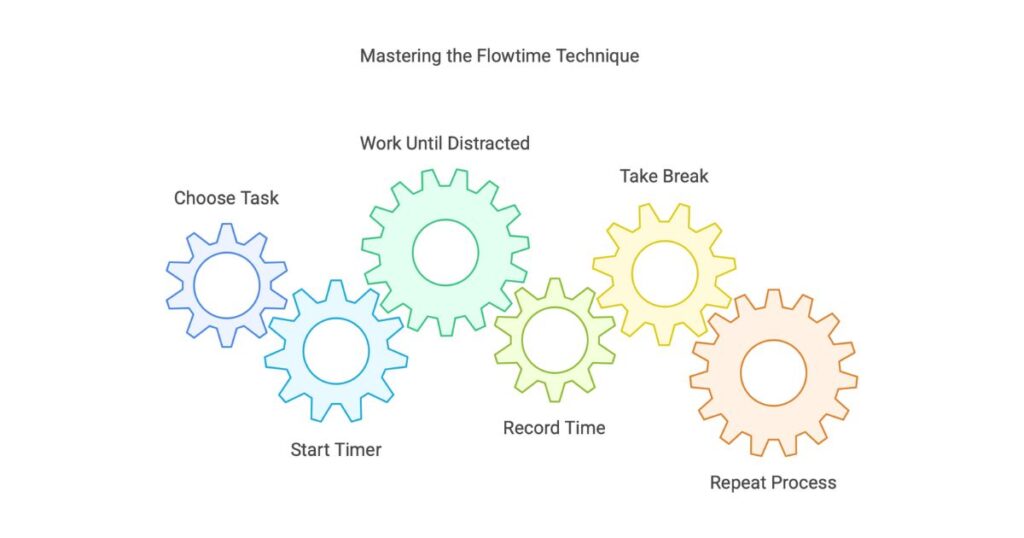Have you ever noticed how your productivity can feel all over the place—super focused one moment, then completely distracted the next? That’s where the Flowtime Technique comes in. It’s a fresh approach to managing your time that could really change the way you work. Let’s take a closer look at how it works and why it might be just what you need.
Why Use the Flowtime Technique?
Picture this: you’re deep into a task, completely focused, and everything is flowing smoothly. But then, a timer interrupts you, pulling you out of your rhythm. Annoying, isn’t it? This is where the Flowtime Technique comes in. Instead of rigidly scheduling breaks, it lets you work with your natural focus—pushing forward when you’re in the zone and taking a breather when you need it. It’s a flexible way to balance work and rest, helping you stay productive without feeling forced.
- Flexibility: Unlike rigid time-blocking methods, Flowtime adapts to your natural rhythms.
- Improved focus: By working until you naturally need a break, you maximize your productive periods.
- Reduced stress: No more watching the clock or feeling guilty about needing longer breaks.
- Better self-awareness: You’ll learn your optimal work patterns and common distractions.
How to Use the Flowtime Technique
Ready to give it a try? Here’s your step-by-step guide to mastering the Flowtime Technique:
- Choose your task: Pick a single task to focus on.
- Start the timer: Begin working and start a timer (but don’t set an end time).
- Work until distracted: Continue working until you feel your focus waning or you get distracted.
- Record your time: Note how long you worked and what distracted you.
- Take a break: Rest for about 10-30% of your work time.
- Repeat: Start the process again with the same or a new task.
Real-life Implementation
Sarah, a freelance graphic designer, was no stranger to missed deadlines. She’d often put things off until the last minute, leaving herself scrambling to finish projects. Tired of the cycle, she decided to give the Flowtime Technique a shot.
On her first day, she set out to design a logo. She started her timer and got to work. To her surprise, she stayed focused for 72 minutes before needing a break. She made a note of the time and realized a Facebook notification had pulled her out of her flow.
After a 10-minute break, she got back to it, this time working for 53 minutes before taking another pause. Over the next few days, Sarah started noticing patterns. She worked best in chunks of 60 to 90 minutes and was most productive in the mornings. With this insight, she reshaped her schedule—tackling her most demanding tasks early in the day and saving client calls for the afternoon.
Within a few weeks, Sarah was hitting her deadlines without the usual stress. The Flowtime Technique had helped her tap into her natural rhythm, making her workdays smoother and more productive.
Template Framework
Ready to implement the Flowtime Technique? Here’s a simple template to get you started:
Date: [Insert Date]
Task: [Describe Your Task]
Session 1:
- Start Time:
- End Time:
- Duration:
- Distraction (if any):
- Break Duration:
Session 2:
- Start Time:
- End Time:
- Duration:
- Distraction (if any):
- Break Duration:
[Continue for as many sessions as needed]
Daily Reflection:
- Most productive time of day:
- Longest focus period:
- Most common distraction:
- Areas for improvement:
History of the Flowtime Technique
The Flowtime Technique was created by Zoë Read-Bivens in 2016 as a more flexible alternative to the Pomodoro Technique. Read-Bivens felt that the Pomodoro’s strict 25-minute work intervals often disrupted her focus, especially when she was in the middle of creative tasks.
Drawing from the psychological idea of “flow”—that state of deep focus and immersion—she designed a method that lets people work for as long as they’re able to stay focused, only taking breaks when they truly need them.
This approach quickly caught on with creative professionals, programmers, and others who thrive during longer, uninterrupted stretches of work. Over time, it’s become even more popular as people look for productivity methods that fit their natural rhythms and energy levels.
The Flowtime Technique reflects a broader shift in how we think about productivity. Instead of rigid, one-size-fits-all systems, it offers a more personalized and adaptable way to work. It’s not just about managing time—it’s about understanding your energy and working with your natural focus cycles.
With the Flowtime Technique, you’re not just tracking minutes; you’re tuning into your own productivity patterns. It’s about finding what works best for you and making the most of it.
Tools You Might Also Like:
- The 2-Minute Rule: A Simple Tool for Greater Productivity
- The Eisenhower Matrix: A Simple Tool for Better Time Management
- The Ivy Lee Method: A Simple Way to Boost Your Productivity
- The 80/20 Rule: Unlocking More with Less Effort
- The Pomodoro Technique: A Simple Tool to Boost Your Productivity
- The Seinfeld Strategy: Building Habits with Consistency
